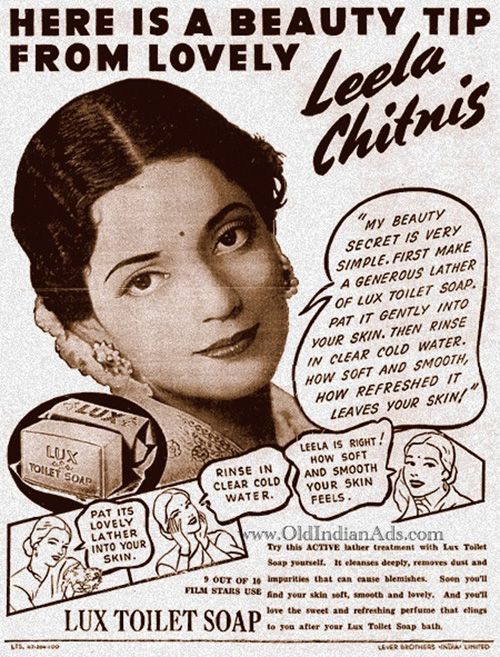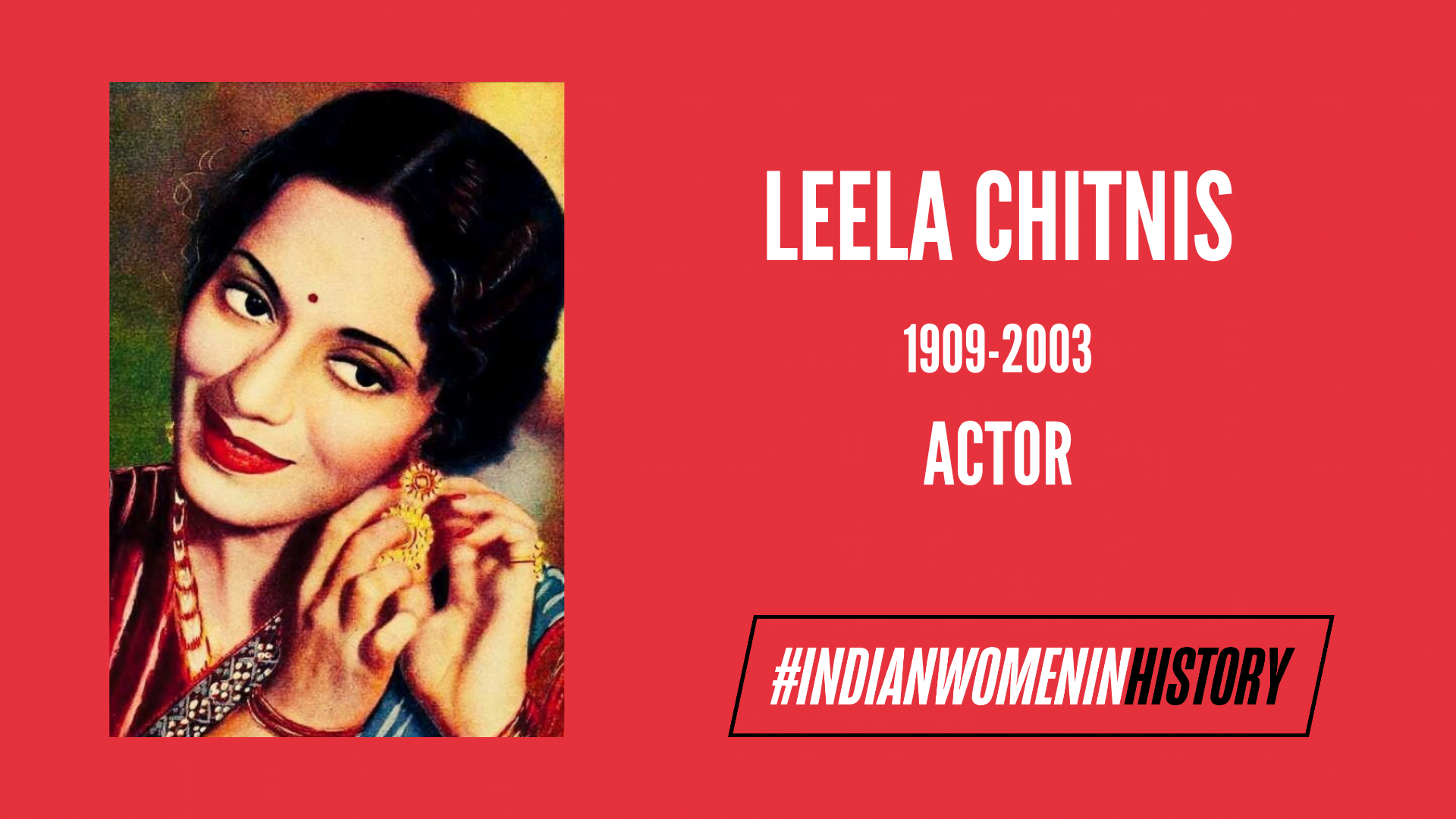Amid the Indian struggle for independence, when women’s education was not yet mainstream, Leela Chitnis made a name for herself as one of India’s first educated heroines. She climbed the ranks of fame, becoming the first Indian face of the luxury soap brand Lux, setting a precedent for Bollywood stardom for generations to come.
Chitnis, hailing from Dharwad, then a part of the Bombay Presidency, began her career as a theatre actress, working for Natyamanwantar, an avant-garde theatre company based in Bombay. She even founded her theatre group, Natyasadhana and then, soon after, moved towards working as an extra in Bollywood films. She entered the film industry in 1935, with her first widely recognised role being in Gentleman Daku (1937) in which she is presented in male attire, even adorning a moustache.
The film’s advertisement featured the following line: “Featuring:– LEELA CHITNIS, B.A., The first Society Lady Graduate on the screen from Maharashtra,” cementing her as an erudite star. She graduated with a BA in English, even securing distinction, but her heart leaned towards acting. After a brief stint in teaching, she turned to acting to earn a living for her family. She was a single mother at the time she began acting as she had separated from her husband, Dr Gajanan Yeshwant Chitnis, whom she married as a teenager. She was not only one of the very few divorced actresses in the industry but also one of the very few mothers playing leading roles.
A subversive debutante’s rise to stardom
She was prominently featured in major films throughout the 1930s and worked under the most prominent production houses, most notably Bombay Talkies. She was known for her strong performances in social films which intended to spread a message and address issues in Indian society. While she started mostly playing ‘good-girl,’ roles, she later also took on subversive roles. In the 1940 film Ardhangi or ‘The Better Half,’ she was seen smoking a cigarette on screen, which although had become normal to show on screen, was wildly unexpected for a woman and especially one of her stature.

Some of her best-known roles, during this period, were in Jailor (1938), Bandhan (1940), Kangan (1939), Ardhangi (1940), and Azad (1940) which made her critically acclaimed and crowd favourite. She was frequently paired alongside Ashok Kumar and the two were considered a star pair. And in 1940, during the peak of her career, she was declared “the star of the year.”
Pitfalls of being a symbol of beauty
She was renowned for her conventional beauty and considered to be looking younger by the day. In 1941, she famously became the ambassador of Lux Soap and was the first Indian actress to hold the role. With this, her image set the precedent for the display of stardom and its confluence with a standard of ideal beauty. At a certain point in her career, her looks gained more focus over her acting abilities and stage presence (which is what initially drew her praise).

Critics began to focus on the shade of her lipstick, its unsuitability to her skin tone, the shape of her nose, and her supposedly overdone makeup while commenting on her performances while the same courtesy was not extended towards her male costars. One review of the hit film Bandhan spends a good paragraph going over the flaws in Chitnis’ makeup in the film after which it moves on to praising Ashok Kumar’s performance and then returns to talking about the film itself. And while she was a figure of stellar beauty, there was also the ticking bomb of ageing that created a lot of anxiety.
A quote from the June 1941 issue of ‘Filmindia,’ magazine said, “Every beautiful girl in the college is now a ‘Chitnis,’ every smile has the Chitnis spontaneity and every blush wears a Chitnis hue,” and later in the same article regretfully questioned the former statement– “Can a champion mother be a heroine to dreamy youth? And who wants a mother for our heroine– certainly not college boys?” effectively destroying their praise of her unbelievable allure. Her image and her perception were always controlled by people, outsiders– men– outside of her reigns.
Leela Chitnis, a victim of the ‘ageing woman,’ trope
The anxiety surrounding an ‘ageing,’ actress playing the leading lady rose strongly towards the mid-1940s when she was only in her 30s; one review of Balu Dalmania’s ‘Ghar Ghar ki Kahani,’ even felt the need to say that she came across as the hero’s mother in the film, ending the review of her performance with just that. Around this time her films also began performing poorly and the spotlight with existed on her during the previous demi-decade was now fading. She got remarried, to C R Gvalani, a Bollwood producer thus further shattering the image of her as a refreshing starlet. She, however, remained unfettered with her ambition. Not only did she continue to act but also explored work behind the camera.
In 1941, she wrote and starred in Kanchan, the next year she produced and starred in Kisise Na Kehna. Later, in 1955 she directed Aaj ki Baat which was released under her banner ‘Leela Chitnis Productions.’ Sadly, however, by now the industry had pigeonholed her into the archetype of the doting, sickly mother.
At the very young age of 39, in 1948, she first slipped into the mother role, delivering a highly acclaimed performance in Shaheed. Ironically, during the release of Shaheed, she also had another picture, Message of Mahatma Gandhi, in which she played the age-appropriate role of the lead– this film is however long forgotten in the pages of film history, and 1948 stands marked as the year Leela Chitnis entered the next stage of her career. She worked till 1987, with her last role being in the drama film Dil Tujhko Diya.
Leela Chitnis is most well known for playing the hero’s mother in films like Awaara (1951), Ganga Jamuna (1961), and Guide (1965) and remains immortalised as such. She passed away in 2003, at the age of 94, leaving behind the legacy of a rather commemorable career; yet, her New York Times obituary left her written as the “duchess of depression.”

Her story then stands as that of a promising star who fell from grace, too early, because of societal projections on the ideal being of a heroine. The men she worked with continued to have their promising careers, with all their upward trajectories and had the good fortune of being immortalised as such while the actresses of her time– Chitnis included– have fallen into obscurity.
Leela’s contemporary, and long-time co-star, Ashok Kumar, for example, in no way suffered the fate of being pushed to the background, away from the strong and brooding hero. He continued dominating the screen for the next decade, only switching to paternal roles in the mid-60s. Often, our heroines only receive their place in history in the context of praise for their exceptional beauty, which also has to be paired with wonderfully acceptable character, absence of scandal, and overall mass appeal.
Leela Chitnis began her career as a wonderfully subversive presence in early Bollywood. As a single mother, sole breadwinner, multi-talented artist, and an educated woman, at a time when Indian women didn’t even have universal franchise, she was a disruptive inspiration and deserves to be remembered as such.
About the author(s)
Spoorthi is a material feminist, academically rooted in cultural studies. She enjoys analyzing films and applying feminist critique to media & media structures.





